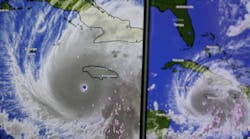The articles in this issue were planned and written before Hurricane Harvey made landfall in Texas as a Category 4 storm, bringing more than 50 inches of rain and causing record flooding in the southeastern part of the state, and well before Hurricane Irma hit Florida just over a week later, leading to the largest evacuation that state has ever seen. We had timed “Paying for Damages” to coincide with hurricane season—just as we planned “Tracking the Storm,” about the new hurricane warning system, for the September issue—because these topics tend to be on readers’ minds at this time of year. We could never have imagined, though, that they’d have such immediate relevance.
As the article notes, Texas and Florida are two of the states with the most properties currently covered by the National Flood Insurance Program—and as we’ve just seen, two with the highest risk of flooding—but even so, not everyone affected was covered. By some estimates, Harvey destroyed as many as 40,000 homes in the Houston area, and roughly 80% of those did not have flood insurance. Many thousands more are damaged, and owners are likely still assessing the feasibility of repair or rebuilding in many cases.
Although it’s little consolation at the moment, the article looks at some possible solutions for flood-prone areas going forward: things like the Community Rating System, in which entire cities and counties can take steps to reduce the likelihood of damage and therefore make insurance for individual homeowners more affordable, and also measures like resilience bonds. One person working on developing these bonds likens them to “life insurance for cities… if you quit smoking, your rates go down.”
The key to both of these concepts is that they require more than the individual homeowner can accomplish alone. “It takes a village” has become a cliché, perhaps, but it’s still often true. Reducing risk and damages requires community-wide efforts like better mapping, stronger zoning, more efficient drainage systems, and clearer public education. It requires keeping people from building, or in some cases rebuilding, in flood zones, or making them elevate structures if they do. In coastal areas, especially, it means taking all possible scenarios into account, including larger storms, rising water levels, and saltwater intrusion from below. It requires looking further into the future than many of us have been willing, up until now, to do.
Looking ahead is important, but looking back can also be instructive. In line with the hurricane tracking and insurance articles I’ve mentioned, an article coming up in our November/December issue has, unfortunately, more relevance than we expected as well. It’s a visit to Biloxi, MS, 12 years after Hurricane Katrina. New Orleans got more attention, but Biloxi was also hit hard and is still rebuilding today. Clearing out the damaged structures and recreating infrastructure takes time and money—lots of money. The one advantage, perhaps, is that starting nearly from scratch has given the city an opportunity to take a hard look at what’s ahead and to rebuild in a way that makes it more resilient, starting with zoning laws that will give it a leg up on its coastal neighbors that haven’t been through the same ordeal.
Biloxi’s story offers some prescient lessons for cities like Houston and all those in Florida that have just weathered their own storms. “It was 30 years before Katrina when Camille made landfall,” says one person who was interviewed for the article, “and people didn’t take it seriously back then. They had parties; they didn’t stockpile supplies. They weren’t ready. Now, we have mitigation in place, and our building codes are tightened…. Even if it’s been 30 or 40 years since a major natural disaster, don’t be nonchalant. Take this seriously, get to work, and be prepared.”
About the Author
Janice Kaspersen
Janice Kaspersen is the former editor of Erosion Control and Stormwater magazines.


